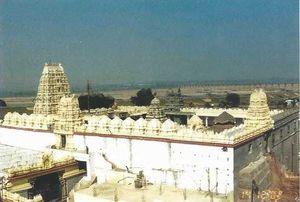Bhadrācalam
By Swami Harshananda
Bhadrācalam literally means ‘mountain of Bhadra’.
Geographical Parameters of Bhadrācalam[edit]
Bhadrācalam is also known as Bhadragīri. It is considered as one of the twenty five important places of pilgrimage associated with Śrī Rāma. It is situated in the Khammam district of Andhra Pradesh. It is 50 km. (31 iles) from Kothagudem, the place famous for the coal mines of Singareni.
Historical Significance of Bhadrācalam[edit]
The sanctum of the temple has the images of Śri Rāma, Sītā and Lakṣmaṇa. According to the sthalapurāṇa (local mythological accounts), they appeared before the sage Bhadra (personification of the mountain Bhadragiri, considered as the son of Meruparvata or mountain Meru and Menakā) and transformed themselves into stone images at his request to stay there permanently. An anthill grew over the images and they were hidden from the human gaze for centuries.
The presence of the images there was revealed accidentally or by divine dispensation to Pokala Dammakka, a childless widow who had adopted a boy named Rāma. She retrieved the images and preserved them, offering a simple worship. One day, in a dream, she saw the sage Bhadra who instructed her to keep up her devoted worship until the time when a great devotee of Śri Rāma comes and constructs a temple for the images.
Later Kañcarla Gopanna (A.D. 1630-1687), the tax-collector of the Muslim ruler Tanisha, visited the place. She revealed her dream to him. Since he was a great devotee of Śrī Rāma, he got the temple built. Though he was punished by the ruler for the ‘misuse’ of State funds, Śrī Rāma came to his rescue in a miraculous way. Gopanna became a famous composer and musician, now well known as Bhadrācala Rāmadāsa.
Important Festivals of the Temple[edit]
The temple was built in the 17th century and was thoroughly renovated during the 1960’s. Śrī Rāma-Navami and Vaikuṇṭha Ekādaśī are the biggest festivals conducted in this temple.
Places To Visit In And Around Bhadrācalam[edit]
Temples of Narasiṅha, Govindarāja, and Rāmadāsa Dhyānamandira are places of importance for the pilgrims. Parṇaśālā, about 36 km (20 miles) away, is the place where Śrī Rāma and Sīta stayed before Sitā was abducted by Rāvaṇa, the demon-king. A rivulet, Sītāvāga by name, flows nearby.
Dummaguḍem is just 16 km or 10 miles from Bhadrācalam. It is the place where Śrī Rāma is said to have killed Khara and his army of 14,000 demons.
Guṇḍala is about 5 km or 3 miles down the river from Bhadrācalam. It contains hot springs and other places of interest.
References[edit]
- The Concise Encyclopedia of Hinduism, Swami Harshananda, Ram Krishna Math, Bangalore


